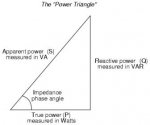Not my area is what I meant to post.It clearly shows how power factor varies with speed for a DC motor. Note this AC input power factor that you would expect for a shunt wound separately excited machine which many are.
There are series wound machines. Typically these are used in traction applications and combustion engine starter motors. High torque at low speed is the main attribute.
I've had a few encounters with them but really my area.
Separately excited shunt wound DC motors very much are.


